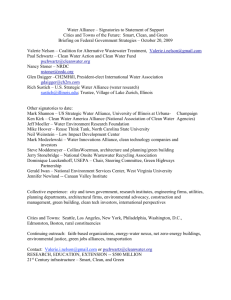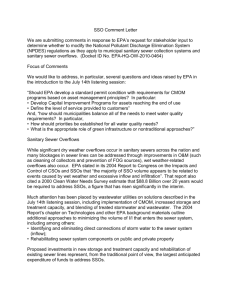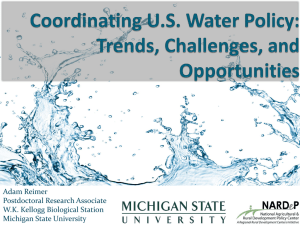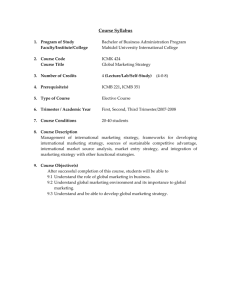Framework for Integrated Municipal Planning Approach
advertisement
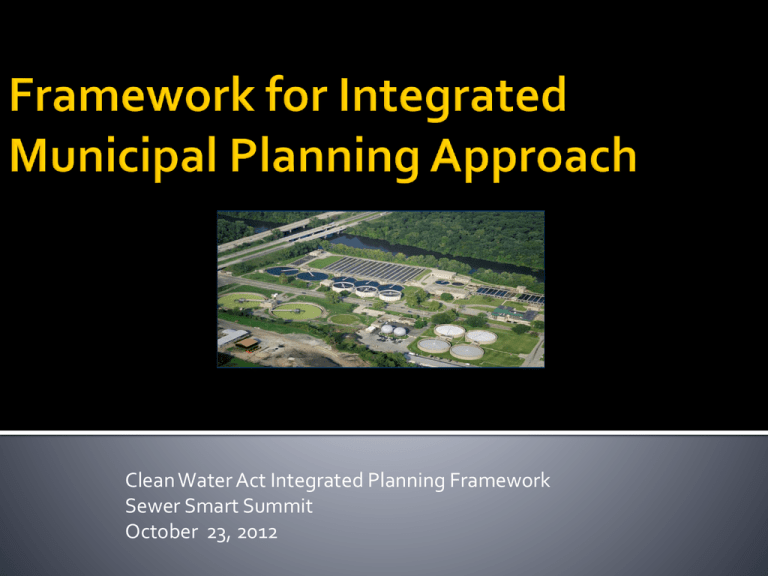
Clean Water Act Integrated Planning Framework Sewer Smart Summit October 23, 2012 THERE ARE NO NEW EPA REGS ASSOCIATED WITH INTEGRATED PLANNING! 2 EPA and States would use the flexibility of EPA’s existing regulations and policies and encourage municipalities to evaluate how best to meet all of their CWA requirements and within their financial capability to better allow— sequencing wastewater and stormwater projects in a way that allows the highest priority environmental projects to come first, and innovative solutions, such as green infrastructure 3 Addresses most serious water quality problems sooner More cost-effective, may lower overall cost of compliance Fosters innovative approaches, such as green infrastructure, that are more sustainable 4 Stakeholder workshops across the country including NACWA and Conference of Mayors 42 written comments received Main issues identified Burdens on States Consistency between HQ and Regions Financial Capability Adaptability Use of Permits Detail SDWA 5 Transmits final Integrated Planning Framework to EPA Regions Encourages Regions to work with States to identify opportunities to implement the integrated planning approach 6 Background Principles Overarching Principles Guiding Principles Elements of an Integrated Plan Implementation Permits Enforcement 7 Integrated planning will maintain existing regulatory standards that protect public health and water quality Integrated planning will allow a municipality to balance various CWA requirements in a manner that addresses the most pressing public health and environmental protection issues first The responsibility to develop an integrated plan rests with municipalities 8 Integrated Plans should: Reflect State requirements and planning efforts and incorporate State input on key issues Provide for meeting water quality standards using existing flexibilities in the CWA and its implementing regulations 9 Maximize the effectiveness of infrastructure dollars through analysis of alternatives and the selection and sequencing of actions needed to address water quality challenges and noncompliance Incorporate effective innovative technologies, approaches and practices (including green infrastructure) 10 Evaluate and address community impacts and consider disproportionate burdens resulting from a municipality’s implementation of its plan Implementation of technology-based and core requirements are not delayed 11 Financial strategy is in place, including appropriate fee structures Opportunity for meaningful stakeholder input throughout the development of the plan 12 Description of the water quality, human health and regulatory issues to be addressed in the plan, including An assessment of existing CWA challenges - current and projected future regulatory requirements Identification and characterization of human health threats Identification and characterization of water quality impairment and threats - TMDLs or an equivalent analysis Identification of sensitive areas and environmental justice concerns Metrics for evaluating human health and water quality objectives 13 Description of existing wastewater and stormwater systems under consideration and summary information describing systems performance, including: Identification of municipalities and utilities that are participating in the planning effort Characterization of wastewater and stormwater systems Characterization of flows in the wastewater and stormwater systems under consideration Identification of deficiencies associated with existing assets 14 Process for involving relevant community stakeholders in the planning and selection process Opportunities for meaningful input during development and selection of alternatives; Making new information available during plan implementation and providing meaningful input into developing proposed modifications; and Public involvement in evaluating the effectiveness of green infrastructure approaches 15 Process for evaluating and selecting alternatives and proposed implementation schedules Use of sustainability planning elements to assist in providing information for prioritizing investments Includes asset management principles A systematic approach to considering green infrastructure and other innovative measures Identification of criteria to be used for comparing alternative projects Identification of alternatives, including cost estimates, projected pollutant reductions and other benefits associated with each alternative Analysis of alternatives that documents the criteria used, the projects selected, and why they were selected. Proposed implementation schedules For each entity participating in the plan, a financial strategy and capability analysis 16 Measuring success Proposed performance criteria and measures of success Monitoring program to address the effectiveness of controls, compliance monitoring and ambient monitoring. 17 A process for identifying, evaluating and selecting proposed new projects or modifications to ongoing or planned projects and implementation schedules based on changing circumstances; and Where the municipality is seeking a modification, they must collect the appropriate information to support the modification. 18 Incorporate all or part of an integrated plan into NPDES permit where legally permissible Considerations for incorporating integrated plans into permits Compliance schedules for meeting WQBELs need to be consistent with the requirements in 40 CFR 122.47 Green infrastructure approaches and related innovative practices Appropriate water quality trading 19



